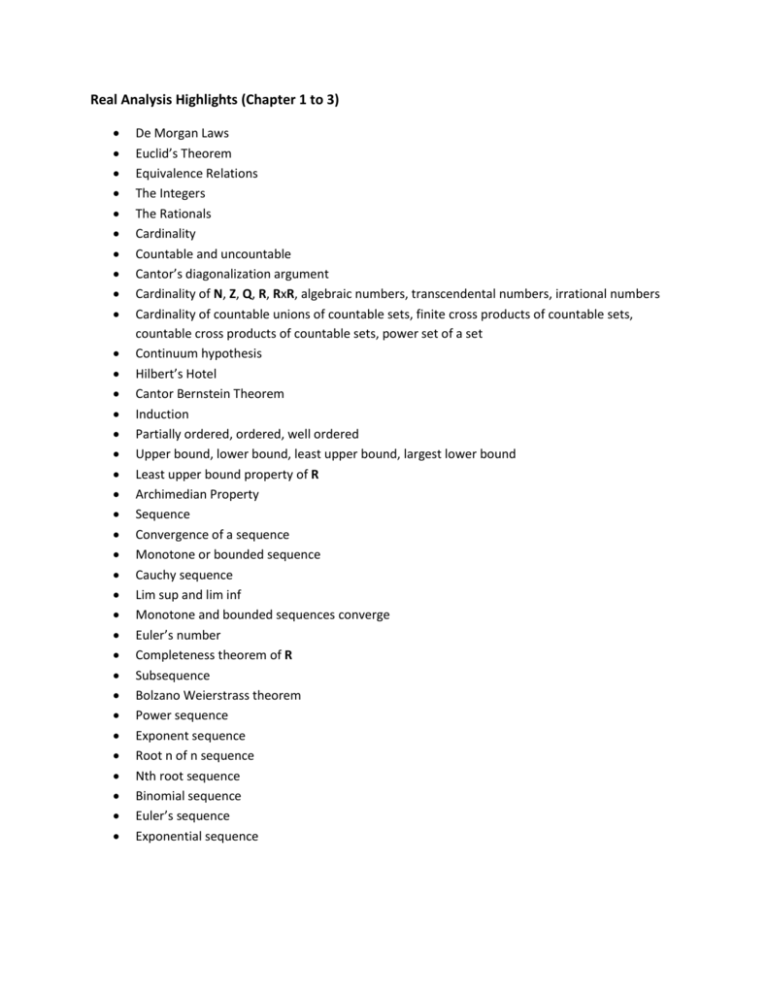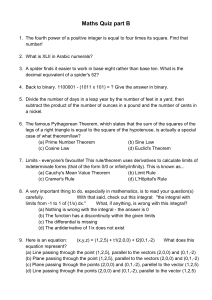Real Analysis Highlights
advertisement

Real Analysis Highlights (Chapter 1 to 3) De Morgan Laws Euclid’s Theorem Equivalence Relations The Integers The Rationals Cardinality Countable and uncountable Cantor’s diagonalization argument Cardinality of N, Z, Q, R, RxR, algebraic numbers, transcendental numbers, irrational numbers Cardinality of countable unions of countable sets, finite cross products of countable sets, countable cross products of countable sets, power set of a set Continuum hypothesis Hilbert’s Hotel Cantor Bernstein Theorem Induction Partially ordered, ordered, well ordered Upper bound, lower bound, least upper bound, largest lower bound Least upper bound property of R Archimedian Property Sequence Convergence of a sequence Monotone or bounded sequence Cauchy sequence Lim sup and lim inf Monotone and bounded sequences converge Euler’s number Completeness theorem of R Subsequence Bolzano Weierstrass theorem Power sequence Exponent sequence Root n of n sequence Nth root sequence Binomial sequence Euler’s sequence Exponential sequence Real Analysis Highlights (Chapter 4 to 5) Series, sequence of partial sums, convergence of a series Absolute and conditional convergence Rearranging absolutely and conditionally convergent series Cauchy Criteria for Series Leaning Tower of Lire and Zeno’s Paradox Convergence Tests o Divergence Test o Comparison Test o Limit Comparison Test o Root Test o Ratio Test o Alternating Series Test o Integral Test Special Series o Geometric Series o Harmonic Series o Alternating Harmonic Series o p Series o Euler’s Series Open and Closed Sets Unions and Intersections of Open and Closed Sets Characterizing open sets Boundary Point and Interior Point Isolated Point and Accumulation Point Closed sets, accumulation points, and sequences Compact Sets Heine Borel Theorem Nested Compact Sets Perfect Sets Perfect Sets are Countable Connected and Disconnected sets The Cantor Set o is perfect o is uncountable but has zero length o does not contain any open set o is totally disconnected Real Analysis Highlights (Chapter 6) Limit of a function (sequence version) Limit of a function (epsilon-delta version) Continuity Uniform Continuity Continuity vs Uniform Continuity Continuity preserves Limits Uniform Continuity preserves Cauchy sequences Types of Discontinuity Monotone functions and discontinuities Characterization of Discontinuity of the Second Kind Continuity and Topology (continuous functions and inverse images of sets) Images of compact sets and of connected sets Max/Min Theorem for continuous functions Bolzano Theorem Intermediate Value Theorem Derivative Derivative as linear approximation Differentiability and Continuity Product, Quotient, and Chain Rule Rolle’s Theorem and Mean Value Theorem Local Extrema L’Hospital Rules A function that is not continuous at any point in R (Dirichlet function) A function that is continuous at the irrational numbers and discontinuous at the rational numbers. A function that is differentiable, but the derivative is not continuous (C1 function) A function that is n-times differentiable, but not (n+1)-times differentiable (Cn function) A function that is not zero, infinitely often differentiable, but the n-th derivative at zero is always zero (Cinf function) A function that is continuous everywhere and nowhere differentiable in R (Weierstrass function) Real Analysis Highlights (Chapter 7) Partition and Riemann Sum Upper and Lower Sum Upper and Lower Riemann Integral Riemann Integral Riemann’s Lemma A function that is not Riemann integrable Continuous functions and the Integral Almost Continuous Functions and the Integral Monotone Functions and the Integral Properties of the Riemann Integral Fundamental Theorem Calculus Integral Evaluation Shortcut A function f such that ∫𝑎 𝑓(𝑡)𝑑𝑡 is not differentiable Antiderivatives Standard Antiderivatives Substitution Rule Integration by Parts Integration by Parts and Limits Mean Value Theorem for Integration Partial Fraction Decomposition Be sure to know how to evaluate the following integrals: 𝑥 1 1 o ∫ sec 2 (𝑥)𝑑𝑥 and ∫ 1+𝑥2 𝑑𝑥 and ∫ √1−𝑥2 𝑑𝑥 o ∫ tan(𝑥) 𝑑𝑥 and ∫ ln(𝑥) 𝑑𝑥 o ∫ 𝑥 2 cos(𝑥) 𝑑𝑥 o ∫ 𝑒 𝑥 cos(𝑥) 𝑑𝑥 o ∫ sin3(𝑥)𝑑𝑥 o ∫ 1−𝑥4 𝑑𝑥 1







